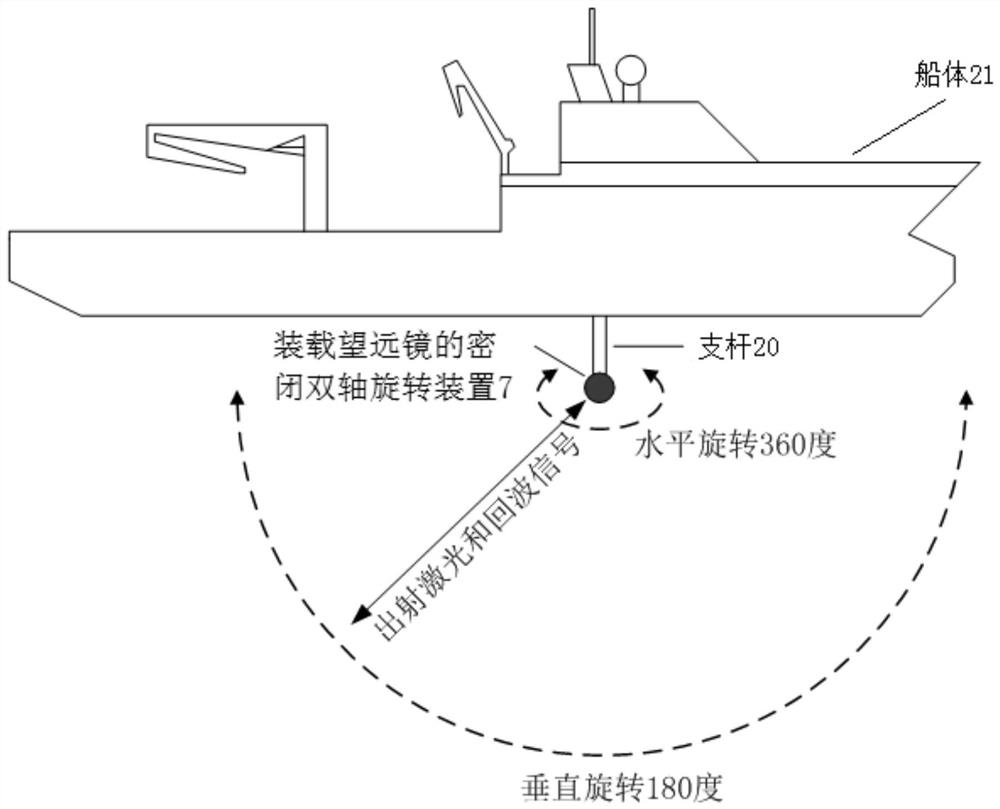Underwater transceiving separated water body detection laser radar
A laser detection and separation technology, applied in measuring devices, electromagnetic wave re-radiation, radio wave measurement systems, etc., can solve problems such as scanning difficulties, system power supply difficulties, and azimuth blind spots, so as to reduce system complexity, solar and The sky background noise is small and the effect of improving accuracy
- Summary
- Abstract
- Description
- Claims
- Application Information
AI Technical Summary
Problems solved by technology
Method used
Image
Examples
Embodiment 1
[0037] The transmitting telescope and the receiving telescope of this embodiment are the transmitting and receiving coaxial telescope 6 , the transmitting and receiving telescopes are shared, and the transmitting and receiving coaxial telescope 6 only includes one.
[0038] Specifically, see figure 1As shown, the present embodiment is a separate water detection laser radar for underwater transceiver, including a near-infrared seed laser 1, an amplifier 2, a frequency multiplier 3, a collimator coupler 4, a narrowband filter 8, The detector 9, the acquisition module 10 and the calculation module 11 also include a transceiver coaxial telescope 6 and an airtight two-axis rotary scanning device 7 arranged below the water surface; the transceiver coaxial telescope 6 is arranged on the airtight two-axis rotary scanning device within 7;
[0039] The near-infrared seed laser 1 generates a near-infrared laser in the 1064nm band. After the near-infrared laser is amplified by the amplif...
Embodiment 2
[0060] The difference between this embodiment and the first embodiment lies in the way of generating blue-green band laser light.
[0061] Specifically, see Figure 4 As shown, the present embodiment is a separate water detection lidar for underwater transceiving, including a pulsed blue-green band laser 19, an amplifier 2, a frequency multiplier 3, a collimator coupler 4, and a narrowband filter arranged above the water surface 8. The detector 9, the acquisition module 10 and the calculation module 11 also include a transceiver coaxial telescope 6 and a sealed two-axis rotating scanning device 7 arranged below the water surface; Inside the scanning device 7;
[0062] The pulsed blue-green band laser 19 produces a blue-green band laser, and the blue-green band laser is amplified by the amplifier 2 to generate a 532nm blue-green band laser suitable for water body detection. The laser at this time is spatial light. The space laser is coupled into the optical fiber through the ...
Embodiment 3
[0066] In this embodiment, the transmitting telescope 15 and the receiving telescope 16 are set separately, and each of the transmitting telescope 15 and the receiving telescope 16 includes one.
[0067] Specifically, see Figure 5 As shown, the present embodiment is a separate water detection laser radar for underwater transceiver, including a near-infrared seed laser 1, an amplifier 2, a frequency multiplier 3, a collimator coupler 4, a narrowband filter 8, The detector 9, the collection module 10 and the calculation module 11 also include a transmitting telescope 15, a receiving telescope 16 and an airtight biaxial rotary scanning device 7 arranged under the water surface; In the axial rotation scanning device 7;
[0068] The near-infrared seed laser 1 generates a near-infrared laser in the 1064nm band. After the near-infrared laser is amplified by the amplifier 2, it enters the frequency multiplier 3 to generate a 532nm blue-green band laser suitable for water body detect...
PUM
 Login to View More
Login to View More Abstract
Description
Claims
Application Information
 Login to View More
Login to View More - R&D
- Intellectual Property
- Life Sciences
- Materials
- Tech Scout
- Unparalleled Data Quality
- Higher Quality Content
- 60% Fewer Hallucinations
Browse by: Latest US Patents, China's latest patents, Technical Efficacy Thesaurus, Application Domain, Technology Topic, Popular Technical Reports.
© 2025 PatSnap. All rights reserved.Legal|Privacy policy|Modern Slavery Act Transparency Statement|Sitemap|About US| Contact US: help@patsnap.com



